What’s the right size for an olympic bar?
In general, an olympic bar is easily identifiable from a standard bar in that the end sleeves of an olympic bar for loading weight plates are 49.8mm-50mm (1.97″) thick. A standard bar has 1″ thick ends.
Olympic bars also come in curved (curl) bars and other specialized types, but I’m concentrating on the straight bars here.
Table of Contents
Length

Anywhere from 5ft long to 8ft or longer, but the most common length is 7ft.
Shaft Length
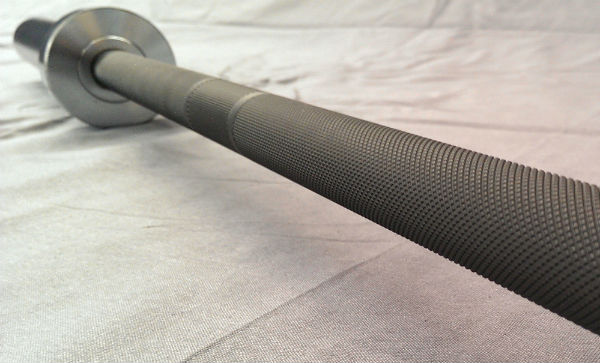
A 7ft bar has about a 52″ grip length between the sleeves, so it will fit on a 48″ wide squat rack (or bench press rack) with the sleeves sitting just outside both sides of the rack.
Some 6ft bars are made to the same dimensions but with the sleeved ends cut short, so they also fit in a 48″ wide rack. Most inexpensive 5ft and 6ft bars, however, will not fit in such a rack.
Sleeve Length
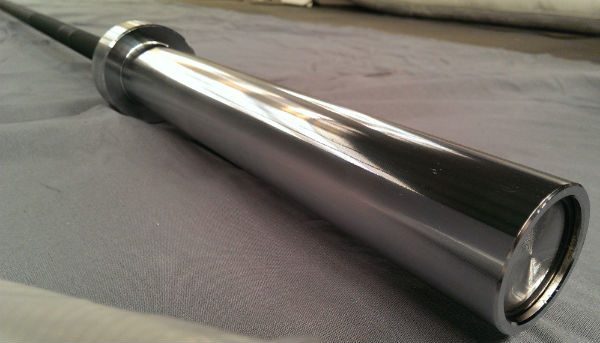
The sleeve length of a 7ft bar is about 16″. A bar with a shorter overall length than 7ft will have shorter sleeves, but they will vary.
With 16″ you may be able to load about (9) 45lb plates on each side, plus collars, but that all depends on the style of plates. Or with bumper plates you can only fit about half that.
Diameter
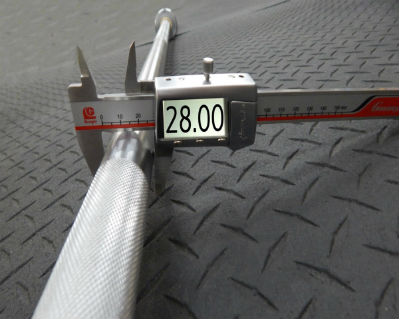
The diameter (thickness) of the shaft ranges from 25mm to 32mm, or 0.98″-1.26″.
Men’s bars are 28mm and higher. 28mm generally provides the best grip for pulling movements like the deadlift and clean-and-jerk, and it lets the bar flex or “whip” somewhat during heavy lifts to help facilitate dynamic movements like the clean-and-jerk.
A 30mm or 32mm bar is often preferred for powerlifting style squats, because the extra thickness makes the bar really stiff and less prone to wobble as the lifter bounces out of the bottom of the squat. A thicker bar also is a way of increasing the strength of a bar.
25mm is reserved for women’s weightlifting bars. Women typically have smaller hands that can’t do a hook grip on a 28mm bar as easily, and 25mm was developed to take that into consideration.
There are also 2″ thick “fat” bars, called axles because they’re so thick they look like car axles, used in strongman competitions. The solid ones weigh 80-100 lbs, so sometimes these are made cheaper and lighter with hollow pipes like this 25lb bar. They are usually constructed with no moving sleeves.
Sleeve Diameter
The sleeved ends of an olympic bar are 50mm or just under 2″ thick. One reason they’re so thick is they are made to spin, so they have to fit a strong shaft inside of the sleeve as well as bushings or needle bearings to facilitate the spin of the sleeves on the shaft.
In the past I’ve found some sleeves of cheap olympic bars to be a little more than 50mm thick. This causes a critical problem when you have tight-fitting (ie: high quality) plates. I haven’t run into that for years, but it’s possible that some brands of the cheapest bars have this problem or have a quality control problem where the issue comes up sometimes.
Weight
An olympic bar is supposed to weigh 20kg or 44 lbs. For American weights in pounds, that has been rounded off to 45 lbs. So you’ll see both 44 and 45 lbs all over the place.
Some cheaper 300 lb olympic weight sets include bars that only weigh about 40 lbs. They don’t tell you that. So the weight set is really only 295 lbs.
Specialty 8ft squat bars will certainly weigh more than 45 lbs, but these bars are rare.
There are also more specific dimensions given by the IWF and IPF for competition purposes. These specs are generally ignored by anyone not conducting high-level competitions, except for the weight, shaft diameter, and rough dimensions.
How much does a weight bench bar weigh?
At any common commercial gym in the US, the bar on a weight bench weighs either 45 lbs or 44 lbs (20 kg). So count it as 45 lbs for easy math. The pair of collars to secure the weight plates on may weigh a pound anyway.
How much does a squat rack bar weigh?
As with the bar on a weight bench, the bar on a squat rack is almost certainly either 45 lbs or 44 lbs (20 kg).
In fact, the bars on a bench press rack or squat rack can usually be used interchangeably. The same bar thickness, knurling, and other factors are optimally about the same on both.
At some powerlifting gyms you may come across a specialty squat bar that is over 7ft long and weighs more like 50 or 55 lbs, but these bars are extremely rare.
IWF Specifications
The International Weightlifting Federation regulates the sport of olympic weightlifting, consisting of the competition lifts the snatch and the clean-and-jerk.
These are sometimes what people refer to when they say “olympic bar,” but olympic bar might also refer to any bar with 2″ sleeves, including powerlifting bars (below). To be more specific they are also called “oly bar”, “WL bar”, or “weightlifting bar”.
IWF specifies the following dimensions for the men’s bars, from the IWF Technical Rules Book.
- Overall length: 220cm / 86.6″
- Shaft grip length: 151cm / 51.6″
- Shaft diameter: 28mm / 1.1″
- Sleeve diameter: 50mm / 1.97″
- Weight: 20kg / 44lb
The knurling pattern is specified in the below diagram. Measurements are in millimeters.

Men’s weightlifting bars generally follow this spec, some with a 28.5mm shaft and with no center knurl. The center knurl is actually a throwback from the days where the one-handed snatch was a competition lift, but today all it does is scratch the front of your neck during cleans.
The women’s weightlifting bar has no center knurling, a 25mm shaft, and shorter sleeves. This makes it smaller for women’s hands, and 11 lbs lighter to be more friendly towards women starting out.
- Overall length: 201cm / 79.1″
- Shaft grip length: 151cm / 51.6″
- Shaft diameter: 25mm / 0.98″
- Sleeve diameter: 50mm / 1.97″
- Weight: 15kg / 33lb

I should mention that there are also “technique” bars that might be any diameter but are generally 6ft long and made of aluminum. The 15 lb weight makes it really easy to learn the snatch safely.
IPF Specifications
The international Powerlifting Federation regulates the sport of powerlifting. The competition lifts are the back squat, deadlift and bench press.
- Overall length: 220cm / 86.6″ or less
- Shaft grip length: 151cm / 51.6″
- Shaft diameter: 28-29mm / 1.1-1.14″
- Sleeve diameter: 50-52cm / 1.97-2.05″
- Weight: 20kg / 44lb (or 25kg including collars)
The knurling pattern for powerlifting bars is shown in the below diagram, taken from the IPF Technical Rules Book.
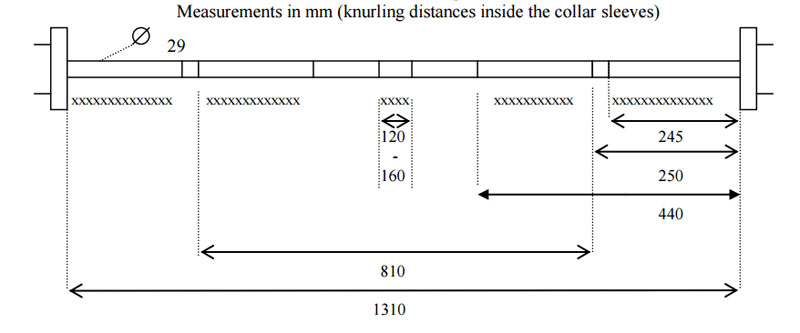
Unlike IWF, IPF doesn’t specify a women’s bar.
As you can see, the IPF specifications are looser than IWF.
Contrasted with the IWF, the IPF spec has a slightly different location for the smooth marks in the knurling used as finger guides, 810mm apart vs 910mm apart. Some “hybrid” bars nowadays include both marks. And the shaft is 29mm. The other specs are pretty similar.
In practice, there are specialized squat and deadlifting bars that are 8ft long, and shaft diameters may be anywhere from 28mm to 32mm, and some don’t have center knurling (the 120-160mm area shown). So most powerlifting bars you’ll find online don’t fit these specifications very well but are still considered powerlifting bars.

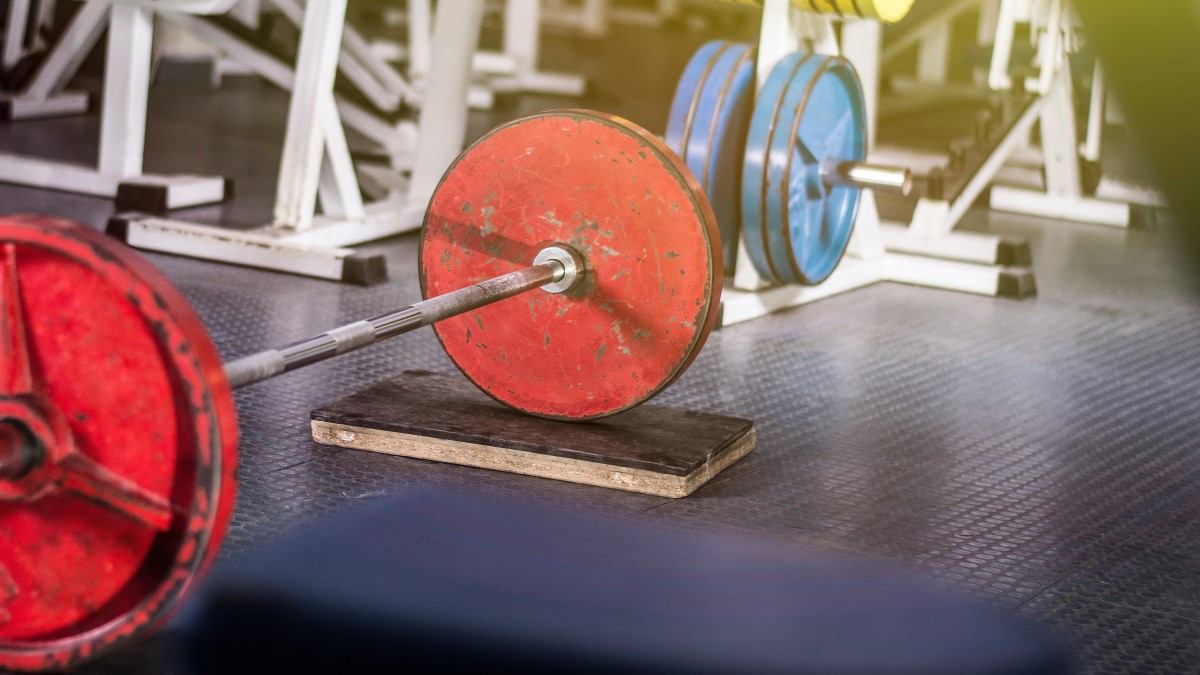
What about the barbell collar diameter?
Can you explain the reason you need it?
lil’ typo. mm not cm, yes?
Fixed, thank you! All this time and nobody pointed it out.